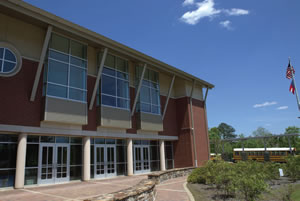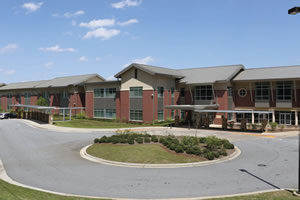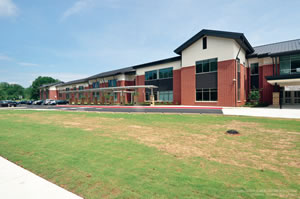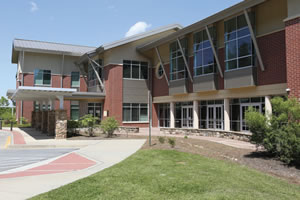I x T = S + E

PHOTOS COURTESY OF FULTON COUNTY (GA.) SCHOOLS
An extended recession has crimped school budgets and created a mountain of deferred maintenance — one that seems to cast an even longer shadow in a time of anemic capital budgets and iffy future prospects for school funding.
Over that same time, however, leaders in the energy and conservation field have continued to light the path to savings and efficiencies, and not just with energy efficient bulbs.
Interviews School Planning & Management conducted with districts that have been recognized by the U.S. EPA and Department of Energy’s Energy Smart program point to a pattern whose underlying principles can expressed in this simple formula:
I x T = S + E, or Information times Technology equals Savings plus Efficiency.
Flipping the Switch
Sue Pierce and Jim Downs, owners of separate school energy consulting businesses associated with Energy Star districts in Arizona and New Jersey, both said they saved their client districts significant amounts of money largely through the power of information.
Downs, of School Energy Solutions, was able to help Mendham Township Middle School in Chester, N.J., realize “something in the order of $600,000 in savings over five years… without any capital improvements.”
Pierce, of Pierce Energy Planning, helped to guide the Washington Elementary School District in Glendale, Ariz., to a 26 percent reductions in energy costs largely by the time getting people in the district to turn things off.
“We’re talking about some nice money there,” she says, “and that’s cumulative.”
Their emphases are different.
Pierce focuses on the “people” side of the equation by creating a culture of conservation. She underscores the importance of taking the time to inform and enlist the support of the superintendent, board of education and key administrators. Only then, she says, did she roll out the program at building and classroom levels by focusing on a piece of technology that’s been around so long we forget it is one: a switch.
“You can turn lights of by flipping a switch each day,” she notes. “It’s free. The best way to save energy is to change behavior.”

PHOTOS COURTESY OF FULTON COUNTY (GA.) SCHOOLS
Pierce warns those who want rush past behavior to install automated controls are more likely to discover that teachers can use shocking low-tech methods wrest back control of temperatures in their classrooms. Just as a room will quickly cool down on a warm day in late spring if a teacher blows hot air onto a thermostat with a hair dryer, it will warm up in the winter if a bag full of ice is duct taped around it on the wall.
Neither action is much more technologically
sophisticated than flipping a switch.
Taking Inventory and Adding Controls
Downs’ path to savings puts greater emphasis on the mechanical systems and starts at square one simply by taking inventory.
School boilers, chillers and air conditioners often are a “patchwork of mechanical and architectural features and controls” that “have been put together over generations,” he says. Moreover, because of retirements and turnover in administrative and mechanical staff, he adds, too often “nobody really knows how to run them.”
Although Downs ntoes it would be possible to use that inventory to create a capital improvements list that could run into the millions, he uses them to create a “you are here” sign that marks the trailhead for a district’s path to energy savings.

PHOTOS COURTESY OF FULTON COUNTY (GA.) SCHOOLS
With the inventory in hand, he explained, it’s possible to decide what current equipment might be incorporated in an updated system, how the district can take advantage of a host of new equipment and controls to fill in the gaps, and what staff training is needed to turn the pieces into an effective and workable system.
Although not a specialist in school facilities, that approach registers with people like Kevin Matthies, who is in charge of commercial sales and engineering for a Springfield, Ohio, HVAC company.
“There’s not a lot of savings in just replacing the (mechanical) equipment,” Matthies notes. “The big thing is the controls.”
A recent Cisco Energy Systems Webinar underscored how big they are by reporting that its Energy Management Solution program helped the Hammond, Ind., school district save more than $42,000 annually following the principle of I x T = S + E.
Information (I) gathered by its suite of programs found that 1,800 of the district’s computers printers and related machines were being left on after hours during the week and 1,200 on the weekends. Through the use of technology (T), operators programmed automatic shut downs that resulted in annual savings and efficiencies (S + E) of $42,000.
Low Hanging Fruit or ‘The Bucks Start Here’
Not surprisingly, Pierce says, districts with cash available can get the best bang for their buck through direct purchase of systems and controls.
Hale Herndon, energy educator and facilities analyst for the award-winning York County (Va.) Schools division says for those who can afford it, geothermal heating and air conditioning systems are the way to go. “They cost a little extra on the front end,” but for districts that can afford them, “what you save on the back end more than makes up” for the investment.
But even districts that can’t afford the optimum choices can make significant progress by harvesting low hanging fruit like the Hammond, Ind., schools did. Because of the amount that can be saved in such a short time, cash strapped districts can enter into performance contracts offered through consultants and system manufacturers.
“The savings we’re creating (for the schools) is paying for all our fees plus an additional 50 to 75 percent” retained by schools, Downs explains. “We only get paid if we’re performing.”
In addition to performance contracting, districts can enter into lease agreements through which schools can, for instance, pay $8,500 for improvements that will guarantee $10,000 in savings within a year, then decide whether to buy the equipment for continued use at contract’s end.
At contract’s end, districts may be in an even better position to go forward because they often qualify for incentive checks like the $10,500 one the Hammond District received from its electricity supplier for the improvements it made. Pierce says every significant energy improvement the districts she advises made resulted in some kind of rebate from a utility company.
The combined savings can allow districts to do what one Midwest university facilities manager calls “using the savings from your low hanging fruit to buy your high hanging fruit.”
Joseph Clements, executive director, facility services, at the award winning Fulton County, Ga., schools says that the higher districts climb, the more they can reap not only energy savings but leverage control systems to save on maintenance costs as well.
Maintenance ‘Cardiology’
Clements says the monitors and sensors built into today’s control systems also provide information that give maintenance staff the potential to diagnose a problem at a computer screen “like a cardiologist reading an EKG.”
Herndon says he sometimes has to remind himself of what an advance that is from 20 years ago, when a repair job was initiated by a call from someone in the office saying “our heat doesn’t work.”
With its built in alarm systems, a control makes it possible not only to ensure a system is repaired before it runs to failure, presumably extending its life, it is a boon to “customer service” because it allows the staff to identify and fix a problem in a way that the customer finds out there was one by learning from the maintenance department that it has been fixed.
Such seamless service also makes maintenance departments more efficient in two ways. First “we know before sending a mechanic out that the pattern looks like a belt being off,” Clements says, so the mechanic can arrive on scene with the needed belt in hand and make a quick fix. Second, that kind of efficiency on individual calls makes the whole department more efficient both by saving time and limiting interruptions to programmed maintenance.
Clements says those efficiencies have allowed the Fulton County Schools to handle a 40 percent increase in the square footage of their buildings over the past decade by adding just two maintenance positions to the previous complement of 16, an increase of 12.5 percent.
One facilities manager says the changes also means “maintenance person is not the guy that carries a hammer in his back pocket anymore.”
Herndon observes that while the York County operation originally put diagnostic computer tablets only in the hands of administrators, it now issues them to its HVAC mechanics, so they don’t have to wait to get clearance to do work that obviously needs to be done.

PHOTOS COURTESY OF FULTON COUNTY (GA.) SCHOOLS
Analyzing Energy. Ison Springs Elementary School is one of the energy-efficient buildings in the Fulton County (Ga.) School District, recognized as a leader by the federal ENERGY STAR program. Joseph Clements, the district’s facilities chief, says he expects analytics, which uses the power of information technology to analyze data from mechanical control systems, to leverage efficiency “to a whole new level.”
Why It’s I x T and Not I + T
To Clements the development of “analytics” is the next big step in using technology in the cause of efficiency. Analytics takes the information available in control systems and uses computing power to analyze it in a systematic fashion, much like diagnostic computers in automotive shops.
The result is an automated use of system knowledge that can be used not only to troubleshoot mechanical systems, but to identify “good outliers” — aspects of the systems that are the top performers. It produces not only savings but a kind of digitized system knowledge built into the programming.
Because operators can write new codes to get even more information from operating systems, the process can continue to grow more sophisticated, leading to new efficiencies.
Downs says staff in one of his districts created a “Snow Day Button” — a program that with a strike of a key can dial all the district’s buildings to maintenance levels as soon as a snow day is declared.
The same kind of programming can address a whole range of energy use issues, so much so that Clements says he expects a person recently hired to exploit this potential by taking analytics to “to a whole new level.”
Toward a “Perfect Formula”
Like any formula that reduces organizational problems to mathematics, I x T = S + E oversimplifies. And there is no element ENERGY STAR award winners place a larger asterisk next to in that regard is what engineers and techies might call the Human Metric and what others simply call people.
Traditionally described as customer service, this element of the operation requires a flexibility of approach that experienced managers say should be designed not only into system controls but programmed into leaders’ minds.
The flexibility takes many forms, including providing temporary overrides that allow dedicated teachers working after school hours to continue to work in a heated room with a working computer. The purpose of the building, after all, is education.
Herndon said that keep his teacher/customers more satisfied, his district allows them a six degree range in which to set their thermostats (plus and minus three degrees from a defined standard). The district also encourages teachers who suspect a room thermostat is malfunctioning to call the office, which will send someone to take a temperature reading at the thermometer.
That simple step has not only built confidence in the system, it “has cut back a huge portion of the work tickets that… go to (the) HVAC (staff),” Clements says, again increasing department efficiency.
Similarly, managers say it’s important to take care of basics like creating heating and cooling zones that allow designated sections or individual rooms to be used after school, on weekends or for summer programs, when needed.
Feedback loops also are important to let teachers and staff know their contributions to energy savings and efficiency are important and valued. In a brilliant move, a superintendent Pierce works with in Arizona announced she was using money saved by energy conservation measures to pay to restore three school days on which teachers were facing unpaid furloughs because of a tight budget.
All this is symphonic music to Pierce’s ears. Although very much a supporter of “smart building technologies,” she says, she is as strongly interested in garnering student and staff support for conservation, whether by involving students in energy audits, pitting them against one another in contests to recycle or reuse materials, or simply raising awareness.
Whatever the merits of I x T = S + E as a formula, Pierce says “the perfect formula is when you can work with the behavior and bring in the technology.”
This article originally appeared in the issue of .